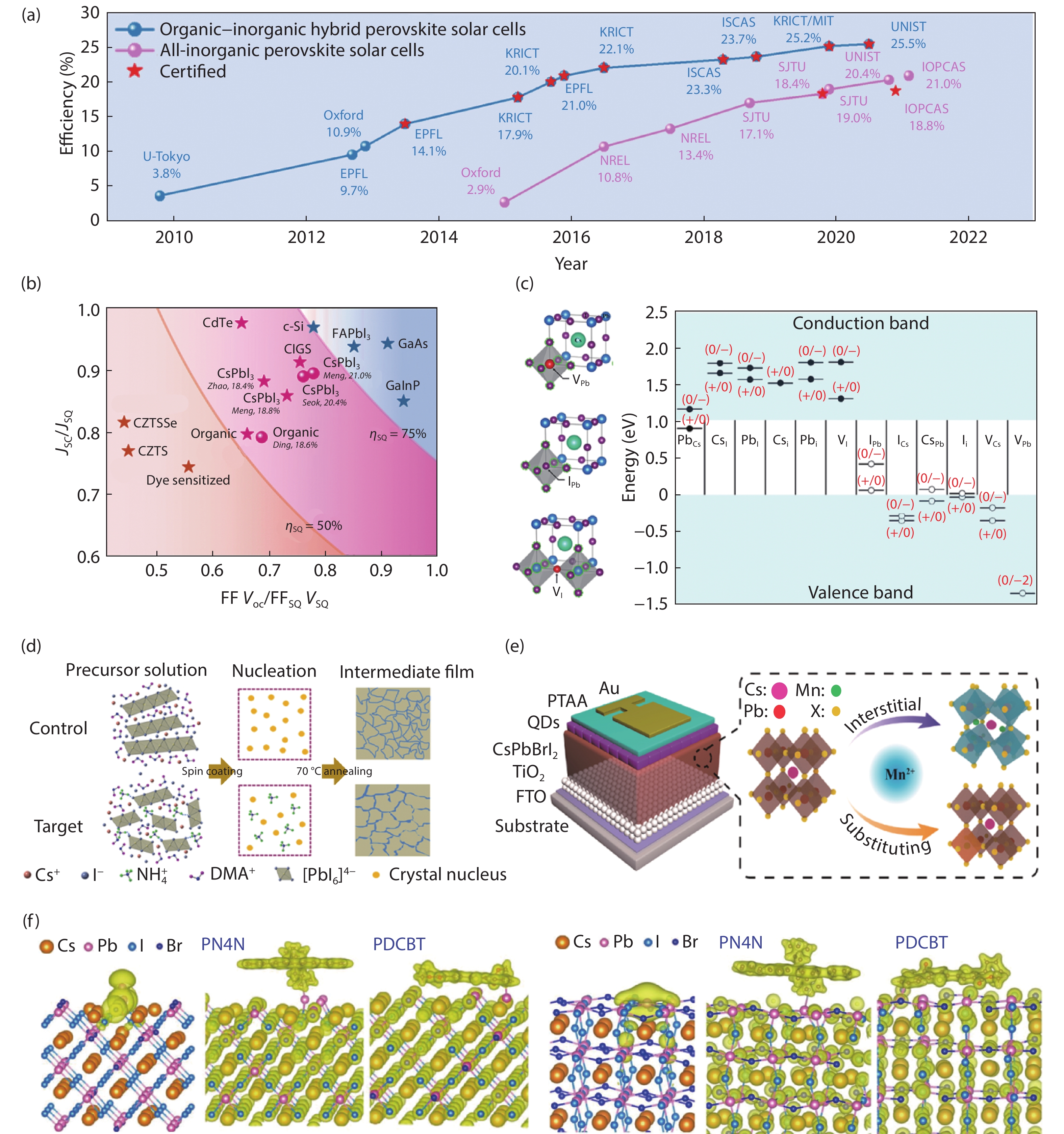| Citation: |
Bingcheng Yu, Chuantian Zuo, Jiangjian Shi, Qingbo Meng, Liming Ding. Defect engineering on all-inorganic perovskite solar cells for high efficiency[J]. Journal of Semiconductors, 2021, 42(5): 050203. doi: 10.1088/1674-4926/42/5/050203
****
B C Yu, C T Zuo, J J Shi, Q B Meng, L M Ding, Defect engineering on all-inorganic perovskite solar cells for high efficiency[J]. J. Semicond., 2021, 42(5): 050203. doi: 10.1088/1674-4926/42/5/050203.
|
Defect engineering on all-inorganic perovskite solar cells for high efficiency
DOI: 10.1088/1674-4926/42/5/050203
More Information
-
References
[1] Huang J, Yuan Y, Shao Y, et al. Understanding the physical properties of hybrid perovskites for photovoltaic applications. Nat Rev Mater, 2017, 2, 17042 doi: 10.1038/natrevmats.2017.42[2] Faheem M B, Khan B, Feng C, et al. All-Inorganic perovskite solar cells: energetics, key challenges, and strategies toward commercialization. ACS Energy Lett, 2020, 5, 290 doi: 10.1021/acsenergylett.9b02338[3] Jia X, Zuo C, Tao S, et al. CsPb(IxBr1– x)3 solar cells. Sci Bull, 2019, 64, 1532 doi: 10.1016/j.scib.2019.08.017[4] Eperon G E, Paterno G M, Sutton R J, et al. Inorganic caesium lead iodide perovskite solar cells. J Mater Chem A, 2015, 3, 19688 doi: 10.1039/C5TA06398A[5] Kulbak M, Cahen D, Hodes G. How important is the organic part of lead halide perovskite photovoltaic cells? Efficient CsPbBr3 cells. J Phys Chem Lett, 2015, 6, 2452 doi: 10.1021/acs.jpclett.5b00968[6] Yoon S, Min H, Kim J, et al. Surface engineering of ambient-air-processed cesium lead triiodide layers for efficient solar cells. Joule, 2021, 5, 183 doi: 10.1016/j.joule.2020.11.020[7] Ho-Baillie A, Zhang M, Lau C F J, et al. Untapped potentials of inorganic metal halide perovskite solar cells. Joule, 2019, 3, 938 doi: 10.1016/j.joule.2019.02.002[8] Green M, Dunlop E, Hohl-Ebinger J, et al. Solar cell efficiency tables (version 57). Prog Photovolt Res Appl, 2021, 29, 3 doi: 10.1002/pip.3371[9] Shockley W, Queisser H J. Detailed balance limit of efficiency of p-n junction solar cells. J Appl Phys, 1961, 32, 510 doi: 10.1063/1.1736034[10] Polman A, Knight M, Garnett E C, et al. Photovoltaic materials: present efficiencies and future challenges. Science, 2016, 352, aad4424 doi: 10.1126/science.aad4424[11] Li Y, Zhang C, Zhang X, et al. Intrinsic point defects in inorganic perovskite CsPbI3 from first-principles prediction. Appl Phys Lett, 2017, 111, 162106 doi: 10.1063/1.5001535[12] Shang Y, Fang Z, Hu W, et al. Efficient and photostable CsPbI2Br solar cells realized by adding PMMA. J Semicond, 2021, 42, 050501 doi: 10.1088/1674-4926/42/5050501[13] Tan S, Shi J, Yu B, et al. Inorganic ammonium halide additive strategy for highly efficient and stable CsPbI3 perovskite solar cells. doi: 10.1002/adfm.202010813[14] Swarnkar A, Mir W J, Nag A. Can B-Site doping or alloying improve thermal- and phase-stability of all-Inorganic CsPbX3 (X = Cl, Br, I) perovskites. ACS Energy Lett, 2018, 3, 286 doi: 10.1021/acsenergylett.7b01197[15] Bai D, Zhang J, Jin Z, et al. Interstitial Mn2+-driven high-aspect-ratio grain growth for low-trap-density microcrystalline films for record efficiency CsPbI2Br solar cells. ACS Energy Lett, 2018, 3, 970 doi: 10.1021/acsenergylett.8b00270[16] Fang Z, Meng X, Zuo C, et al. Interface engineering gifts CsPbI2.25Br0.75 solar cells high performance. Sci Bull, 2019, 64, 1743 doi: 10.1016/j.scib.2019.09.023[17] Wang Y, Dar M I, Ono L K, et al. Thermodynamically stabilized β-CsPbI3-based perovskite solar cells with efficiencies > 18%. Science, 2019, 365, 591 doi: 10.1126/science.aav8680[18] Wang Y, Liu X, Zhang T, et al. The role of dimethylammonium iodine in CsPbI3 perovskite fabrication: additive or dopant. Angew Chem Int Ed, 2019, 58, 16691 doi: 10.1002/anie.201910800[19] Fang Z, Liu L, Zhang Z, et al. CsPbI2.25Br0.75 solar cells with 15.9% efficiency. Sci Bull, 2019, 64, 507 doi: 10.1016/j.scib.2019.04.013[20] Tian J, Xue Q, Tang X, et al. Dual interfacial design for efficient CsPbI2Br perovskite solar cells with improved photostability. Adv Mater, 2019, 31, 1901152 doi: 10.1002/adma.201901152[21] He X, Qiu Y, Yang S. Fully-inorganic trihalide perovskite nanocrystals: a new research frontier of optoelectronic materials. Adv Mater, 2017, 29, 1700775 doi: 10.1002/adma.201700775[22] Yang D, Li X, Zhou W, et al. CsPbBr3 quantum dots 2.0: benzenesulfonic acid equivalent ligand awakens complete purification. Adv Mater, 2019, 31, 1900767 doi: 10.1002/adma.201900767 -
Proportional views






 DownLoad:
DownLoad:














